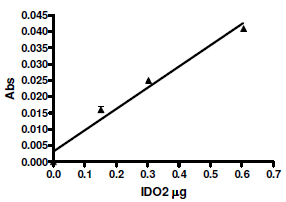Mouse IDO2 Inhibitor Screening Assay Kit
Catalog #
72042
$1,950
*
●
●
Purchase
Description
The Mouse IDO2 Inhibitor Screening Assay Kit is designed to measure Mouse IDO2 enzyme inhibition. The Mouse IDO2 Inhibitor Screening Assay Kit is simple to use. Inhibitor and enzyme are added to a sample containing L-Trp substrate. After a room temperature incubation, activity is determined by measuring the absorption of reaction product at λ=320 – 325 nm.
●
Synonyms
Indoleamine 2,3-dioxygenase 2, IDO-2, IDO, activity assay kit
●
Product Data Gallery
Product Info
Storage and Usage
Citations
Assay Kit Format
Colorimetric - UV Spectrophotometry
Supplied As
The kit comes in a convenient format with enough reaction solution and enzyme to perform a total of 100 reactions.
Materials Required But Not Supplied
Spectrophotometer capable of measuring absorbance at λ=320 – 325 nm.
Adjustable micropipettor and sterile tips
Format
| Catalog Number |
Component | Amount | Storage | |
| 71240 | Mouse IDO2 His-Tag* | 2 x 500 µg | -80°C | Avoid freeze/ thaw cycles! |
| IDO2 Reaction Solution component 1 | 2 x 10 ml | -20°C | ||
| IDO2 Reaction Solution component 2 | 2 x 100 µl | -20°C | ||
| IDO2 Substrate | 2 x 1 ml | -20°C | ||
| 1x IDO2 Assay Buffer | 5 ml | -80°C | ||
| UV transparent 96-well plate | 1 | Room Temp | ||
*The initial concentration of Mouse IDO2 is lot-specific and will be indicated on the tube containing the enzyme.
Background
L-tryptophan (L-Trp) is an essential amino acid necessary for protein
synthesis in mammalian cells and the L-Trp to kynurenine (Kyn) pathway is firmly established as
a key regulator of innate and adaptive immunity. Catabolism of L-Trp to Kyn maintains an
immunosuppressive microenvironment by starving immune cells of L-Trp and releasing
degradation products of L-Trp that have immunosuppressive functions. Indoleamine 2,3-
dioxygenases (IDO1 & IDO2), two of the rate limiting enzymes in this pathway, are upregulated
in many tumors, providing cancer cells with an avenue for immune evasion.
References
1. Liu, X., et al., Blood. 2010; 115(17): 3520-3530.
2. Seegers, N., et al. J. Biomol. Screen. 2014; 19(9): 1266-74.
2. Seegers, N., et al. J. Biomol. Screen. 2014; 19(9): 1266-74.


